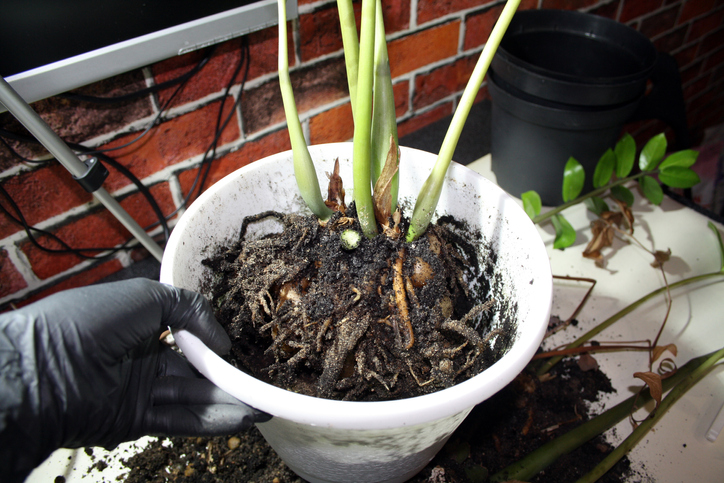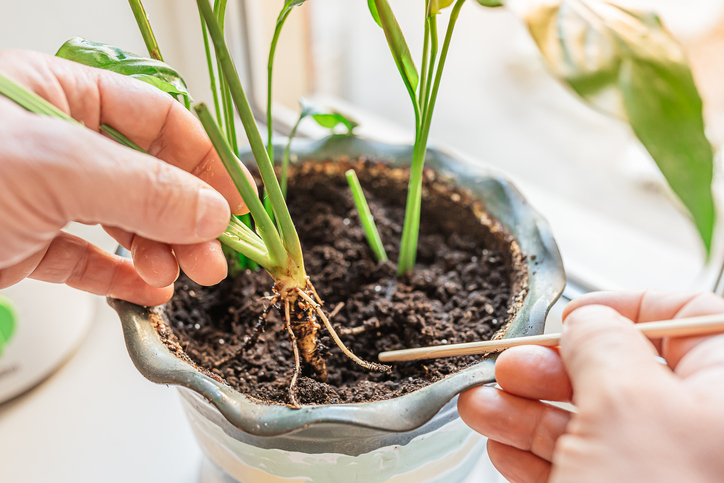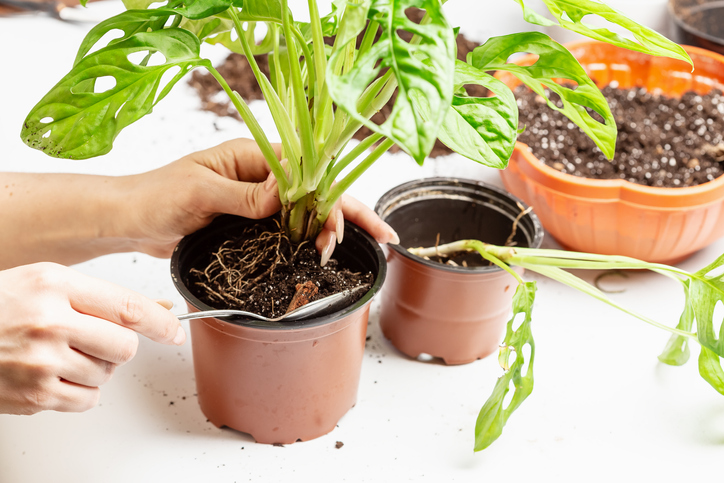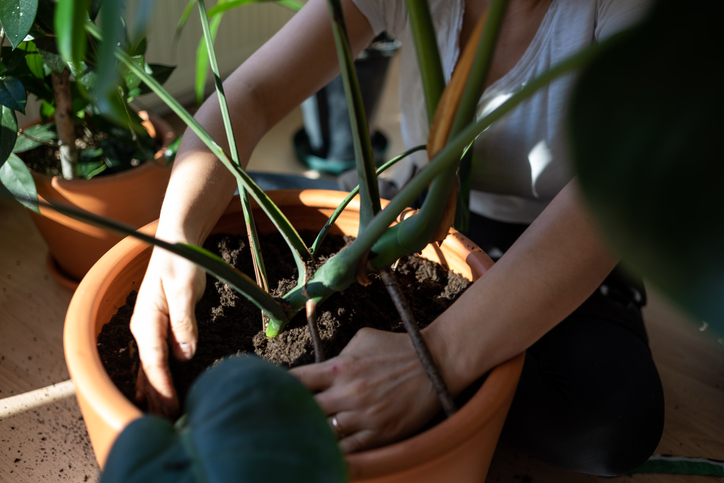Root rot in Monstera is one of the biggest problems that plant growers face when growing Monstera indoors.
This article will discuss the root rot problem, what you need to look for in potted plants to detect root rot, and more.
What is Root Rot?
The phytophthora Root Rot is a group of fungal infections that describe a disease that affects the Monstera roots.
It can be caused by many fungi, including Armillaria mellea, Clitocybe tabescens, and Fusarium. One common disease is Rhizoctonia root rot.
Root decay can cause the roots to deteriorate by absorbing the root’s nutrients or releasing chemicals to break down the roots.
The deterioration of the roots can lead to the weakening of the plant and, eventually, the death of the plant.
Monstera plants such as the Monstera deliciosa, also called the Swiss Cheese Plant, are especially prone to rot. Hence, it is essential to know about root rot, how to identify it, and how to treat it.

Root Rot and Healthy Roots Monstera
The Monstera genus is known for its aerial roots and vining growth. However, root rot can result in stunted growth and other problems, and it is already too late when you realize that your plant is infected.
Hence, it becomes essential to know what to look for in the Monstera to check if it is infected.
Related Guide: Monstera Philodendron Types
Root Rot and Healthy Roots Monstera
The Monstera genus is known for its aerial roots and vining growth. However, root rot can result in stunted growth and other problems, and it is already too late when you realize that your plant is infected.
Hence, it becomes essential to know what to look for in the Monstera to check if it is infected.
How Healthy Monstera Roots Should Look
Root rot generally occurs in roots that are in the soil. The infection can pass to aerial roots, but by then, the infection is at its worse.
You can judge how a healthy Monstera root should be based on three factors: root color, root texture, and root smell.
Roots do not have chlorophyll, a pigment responsible for making the plants green. Hence, healthy plants have brown and slightly white roots at the tip.
Dark brown or black roots are an indication of an infection.
Healthy plant roots are firm, thick, long, and rough to touch. This allows the roots to reach deep into the soil for nutrients and water.
Monstera roots are especially long and are known to break out of the pot. Infected roots usually lose their shape and become slimy.
Healthy plant roots give a scent similar to the soil, a king of muddy and dirt-like smell. Infected roots give off a smell of rotting and sulfur.

Signs of Root Rot
Plants infected with root fungus give off specific signals that make it easier to diagnose the problem.
The Monstera root rot signs can be divided into early warning signs and advanced signs.
Early warning signs are difficult for some people to note, but you can successfully treat the plant at that stage.
Advances signs are easier to notice because they indicate that the root rot infection has increased tremendously. At that stage, saving the Monstera is less likely.
1. Yellowing Leaves with Blackspots
If the Monstera is infected with root rot, you will notice some yellowing leaves, and you should check the root system and the soil for rot or excess water. A healthy Monstera’s leaves are green, and yellow leaves are a sign of stress.
Additionally, black spots will start appearing on the affected leaves, indicating that root rot in Monstera has spread to the plant’s stem and leaves. The appearance of blackspots is an advanced warning sign that indicates later stages of the disease.
2. Foul Odor
Monstera root rot is caused by a fungus that causes the decaying of the roots. Rotting roots give off a harsh odor of sulfur or decaying, a clear indicator of root rot. A foul smell is an early warning sign; you can still treat the plant.
3. Wilted Leaves
Monstera leaves wilt when they are not getting enough water. Wilting is a defense mechanism for plants to decrease water loss. This can be caused by underwatering, overfeeding (too much organic matter), or the roots not absorbing water due to damage.
Wilted leaves are a later sign of the early stages of root rot, indicating that the damage caused by the decay is significant. Damaged roots are one of the biggest problems of fungal root rot.
4. Discoloration of the roots
As mentioned before, healthy plant roots tend to be brown or whitish. Rotting mushy roots are black or dark brown. To check the root color, you will need to dig up the roots from the soil.
Discolored roots are an early warning sign that can be treated by cutting off the infected parts to avoid spreading. This sign means that the root system is no longer viable, and the plant’s roots are dead.
5. Thinning and Darkening Stems
Stem rot is one of the signs of root rot. Monstera stems are usually thick and light green. However, fungal diseases that have progressed to a more advanced root rot may cause the stems to become thin.
Furthermore, a clear sign of the fungal spread is when the stem turns squishy and starts to blacken.
The decaying stem fails to translocate food throughout the plant, and water no longer flows naturally, leading to the death of the plant. If you notice thinning stems that have started to decay, your Monstera is beyond saving.

What Causes Root Rot in Monstera
As mentioned before, Monstera root rot is caused by a fungal infection. However, such diseases do not happen coincidentally; but several factors influence the start of Monstera root rot, the two main factors being the fungus and overwatering the plants.
Fungus
Fungi are a group of parasitic and saprophytic microorganisms, meaning they feed on living and dead material. These microorganisms might already live in the potting mix or the pot you use for your Monstera.
In such a case, they start to grow and spread after fulfilling some requirements, mainly temperature and water, causing root rot.
These fungi can also enter the Monstera soil through their spores. These spores travel through the air until they find a suitable host, which in this case is the Monstera’s root rot.
Hence, the chances of your Monstera getting root rot are increased if another plant in your home is infected.
Over-watering
Overwatering is the second major reason for root rot. Overwatering the Monstera can happen in more ways than just watering your Monstera frequently or too much.
To prevent watering the Monstera plant more than it needs, touch the top few inches of the soil to check soil moisture; if it feels dry, water the Monstera. Generally, over-watering your plant once does not immediately lead to rot, but it occurs over days.
Another reason for over-watering can be poor drainage. You must place the Monstera in a pot with a drainage hole at the bottom, allowing the water to seep and not collect. A proper drainage system is essential for Monstera’s growth.
Additionally, make sure to use well-aerated soil. Regular garden soil retains excess moisture, and damp soil is unsuitable for the Monstera. You can make more drainage holes in the pot to avoid a soggy soil mix.
Some houseplant owners tend to add rocks at the bottom of the potting soil to increase drainage. However, contrary to that belief, rocks at the bottom of the pot result in less drainage.
Drainage in the pot only occurs when the lower part is soaked, which can take time since the soil above soaks up water. Putting rocks at the bottom of the pot only raises the soil higher, making the water take longer to reach the drainage holes.
A pot that is too big can also cause the water to stay stagnant. This is because the pot leaves a lot of soil patches where the Monstera’s roots do not reach; hence the water stays in these patches, giving the perfect conditions for the growth of the fungus.
Another reason for over-watering is, ironically, underwatering. When you do not water the plant a lot, the Monstera’s roots tend to adapt and shrink, creating more rootless patches in the soil. Eventually, watering the plant with the same amounts tends to be more than required.
Temperature is another factor that causes you to overwater your Monstera plant. At lower temperatures, the plant’s growth is slowed and does not take up as much water and nutrients as needed during its growing periods.
This results in the water and nutrients being left behind in the soil.
How to Treat Monstera Root Rot

First and foremost, you must try to prevent root rot as best you can. If your Monsteras roots are infected, there are specific ways to treat them.
Remove all the soil and, using pruning shears, cut off dead or blackened roots beyond saving and focus on the remaining roots. Finally, treat the infected parts.
You can use healthy stem cuttings to grow a new plant through soil propagation.
You can disinfect roots with different chemicals, which are natural fungicides.
1. Hydrogen peroxide
Hydrogen peroxide is an industrial disinfectant used widely to sterilize equipment and areas. Add a tablespoon of three percent of the peroxide to a cup of water and use it directly on the roots.
Fungi that cause root infections are anaerobes, meaning they grow well without oxygen. Hydrogen peroxide has extra oxygen molecules that create an imbalance in the anaerobic environment of the soil.
2. Apple Cider Vinegar
To fix root rot, add apple cider vinegar to a gallon of water and spray it on the infected parts of the plant and as much soil as possible.

Soil Recommendation
Using well-aerated soil with adequate drainage features is the best way to prevent rot. Generally, coco coir or peat moss soil works best as it has good water retention abilities without leading to an infection. Resulting in a healthy root system for your plant.
Frequently Asked Questions
1. Can I reuse the contaminated soil again?
Absolutely not. Even after treating the soil, there is no guarantee that the fungus spores do not exist in the infected soil, making it extremely risky to reuse. Always use fresh soil mix.
2. Can I successfully treat root rot?
The success of the treatments depends on the intensity of the infection. It is better to throw out the entire plant than to save it.

My name is Daniel Elrod, and I have been houseplant love ever since I was 17. I love how much joy they bring to any room in the home. I’ve always been amazed at how a few pots of flowing leaves can turn a drab and sterile office into an inviting place where people love to work at.






